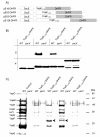Yersinia enterocolitica type III secretion: evidence for the ability to transport proteins that are folded prior to secretion
- PMID: 15248901
- PMCID: PMC471551
- DOI: 10.1186/1471-2180-4-27
Yersinia enterocolitica type III secretion: evidence for the ability to transport proteins that are folded prior to secretion
Abstract
Background: Pathogenic Yersinia species (Y. enterocolitica, Y. pestis, Y. pseudotuberculosis) share a type three secretion system (TTSS) which allows translocation of effector proteins (called Yops) into host cells. It is believed that proteins are delivered through a hollow needle with an inner diameter of 2-3 nm. Thus transport seems to require substrates which are essentially unfolded. Recent work from different groups suggests that the Yersinia TTSS cannot accommodate substrates which are folded prior to secretion. It was suggested that folding is prevented either by co-translational secretion or by the assistance of specific Yop chaperones (called Sycs).
Results: In this study we have fused YopE secretion signals of various length to the mouse dihydrofolate reductase (DHFR) in order to analyse the DHFR folding state prior to secretion. We could demonstrate that secretion-deficient as well as secretion-competent YopE-DHFR fusions complexed to SycE can be efficiently purified from Yersinia cytosol by affinity chromatography using methotrexate-agarose. This implies the folding of the DHFR fusion moiety despite SycE binding and contradicts the previously presented model of folding inhibition by chaperone binding. Secretion-deficient YopE-DHFR fusions caused severe jamming of the TTSS. This observation contradicts the co-translational secretion model.
Conclusions: We present evidence that the Yersinia TTSS is familiar with the processing of transport substrates which are folded prior to secretion. We therefore predict that an unfoldase is involved in type III secretion.
Figures





References
-
- Cornelis GR. The Yersinia Ysc-Yop virulence apparatus. Int J Med Microbiol. 2002;291:455–462. - PubMed
Publication types
MeSH terms
Substances
LinkOut - more resources
Full Text Sources

